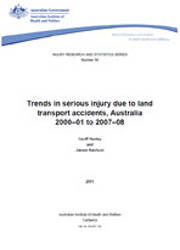Summary
This report presents estimates of trends in the number and rate of persons injured in Australia due to road traffic crashes. Trends are considered statistically significant if the 95% confidence interval (CI) does not include zero. Serious injury is defined as when the person was admitted to hospital for their injury. High threat to life, or life threatening, injury are a subgroup of hospitalised injury for which severe injury diagnoses were reported. Injury deaths are not included in this report.
Trends in serious injury
Over the 8-year period from 2000–01 to 2007–08, age-standardised rates for persons seriously injured due to a road traffic crash increased from 138.4 to 153.4 per 100,000 population, an average annual increase of 1.7% (CI: 1.5% to 1.9%).
All jurisdictions except for Victoria and the Northern Territory experienced significant increases in age-standardised rates of serious injury due to involvement in a road crash over the 8-year period.
Trends in life-threatening injury
Over one-quarter (28%) of those seriously injured due to a road crash sustained life- threatening injuries over the 8-year period from 2000–01 to 2007–08.
For males, those aged 15–24 years had the highest age-specific rates, while for females, those aged 15–24 years and those aged 65 years and over had the highest age-specific rates.
Drivers of motor vehicles, motor cyclists and pedal cyclists all recorded significant increases in age-standardised rates of life-threatening injury over this period.
Motorcyclists recorded an average annual rate of increase of 7.4% (CI: 6.5% to 8.3%). For males in all age groups except aged 0–4 years, there were significant increases in age-specific rates over the 8-year period. The largest increases in rates were recorded in the 45–64 years and 65 years and over age groups which recorded average annual increases of 15.5% (CI: 13.3% to 17.6%) and 12.7% (CI: 7.1% to 18.5%) respectively. For female motorcyclists there were significant increases for those aged 25–44 years and 45–64 years.
Pedal cyclists recorded an average annual rate of increase of 7.5% (CI: 6.2% to 8.7%). For both males and females in age groups 25–44 years, 45–64 years and 65 years and over, there were significant increases in age-specific rates over the 8-year period. The largest rate increase for males was recorded for those aged 45–64 years with an average annual increase of 15.1% (CI: 12.3% to 18.0%), while for females the largest rate increase was recorded for those 65 years and over with an average annual increase of 12.2% (CI: 1.0% to 24.6%).
For males aged 45–64 years, the combined total of high threat to life injuries due to motorcycle and pedal cycle road traffic crashes as a percentage of all high threat to life injuries due to road traffic crashes rose from almost 30% in 2000–01 to 50% in 2007–08.
Persons living in remote areas recorded the highest rate of increase with an average annual rate of increase of 6.1% (CI: 3.3% to 9.0%), while persons living in major cities and outer regional areas recorded smaller, but significant average annual rates of increase.



